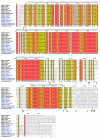NDE1 and NDEL1: twin neurodevelopmental proteins with similar 'nature' but different 'nurture'
- PMID: 24093049
- PMCID: PMC3787581
- DOI: 10.1515/bmc-2013-0023
NDE1 and NDEL1: twin neurodevelopmental proteins with similar 'nature' but different 'nurture'
Abstract
Nuclear distribution element 1 (NDE1, also known as NudE) and NDE-like 1 (NDEL1, also known as Nudel) are paralogous proteins essential for mitosis and neurodevelopment that have been implicated in psychiatric and neurodevelopmental disorders. The two proteins possess high sequence similarity and have been shown to physically interact with one another. Numerous lines of experimental evidence in vivo and in cell culture have demonstrated that these proteins share common functions, although instances of differing functions between the two have recently emerged. We review the key aspects of NDE1 and NDEL1 in terms of recent advances in structure elucidation and cellular function, with an emphasis on their differing mechanisms of post-translational modification. Based on a review of the literature and bioinformatics assessment, we advance the concept that the twin proteins NDE1 and NDEL1, while sharing a similar 'nature' in terms of their structure and basic functions, appear to be different in their 'nurture', the manner in which they are regulated both in terms of expression and of post-translational modification within the cell. These differences are likely to be of significant importance in understanding the specific roles of NDE1 and NDEL1 in neurodevelopment and disease.
Figures





References
-
- Sasaki S, Shionoya A, Ishida M, Gambello MJ, Yingling J, Wynshaw-Boris A, Hirotsune S. A LIS1/NUDEL/cytoplasmic dynein heavy chain complex in the developing and adult nervous system. Neuron. 2000;28:681–96. - PubMed
-
- Niethammer M, Smith DS, Ayala R, Peng J, Ko J, Lee MS, Morabito M, Tsai LH. NUDEL is a novel Cdk5 substrate that associates with LIS1 and cytoplasmic dynein. Neuron. 2000;28:697–711. - PubMed
-
- Kitagawa M, Umezu M, Aoki J, Koizumi H, Arai H, Inoue K. Direct association of LIS1, the lissencephaly gene product, with a mammalian homologue of a fungal nuclear distribution protein, rNUDE. FEBS Lett. 2000;479:57–62. - PubMed
-
- Feng Y, Olson EC, Stukenberg PT, Flanagan LA, Kirschner MW, Walsh CA. LIS1 regulates CNS lamination by interacting with mNudE, a central component of the centrosome. Neuron. 2000;28:665–79. - PubMed
-
- Sweeney KJ, Prokscha A, Eichele G. NudE-L, a novel Lis1-interacting protein, belongs to a family of vertebrate coiled-coil proteins. Mech Dev. 2001;101:21–33. - PubMed
Publication types
MeSH terms
Substances
Grants and funding
LinkOut - more resources
Full Text Sources
Other Literature Sources
